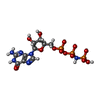+ Open data
Open data
- Basic information
Basic information
| Entry | Database: PDB / ID: 1p2v | ||||||
|---|---|---|---|---|---|---|---|
| Title | H-RAS 166 in 60 % 1,6 hexanediol | ||||||
 Components Components | Transforming protein p21/H-RAS-1 | ||||||
 Keywords Keywords | SIGNALING PROTEIN / MOLECULAR SWITCH PROTEIN | ||||||
| Function / homology |  Function and homology information Function and homology informationphospholipase C activator activity / GTPase complex / oncogene-induced cell senescence / positive regulation of miRNA metabolic process / positive regulation of ruffle assembly / T-helper 1 type immune response / positive regulation of wound healing / defense response to protozoan / regulation of neurotransmitter receptor localization to postsynaptic specialization membrane / Signaling by RAS GAP mutants ...phospholipase C activator activity / GTPase complex / oncogene-induced cell senescence / positive regulation of miRNA metabolic process / positive regulation of ruffle assembly / T-helper 1 type immune response / positive regulation of wound healing / defense response to protozoan / regulation of neurotransmitter receptor localization to postsynaptic specialization membrane / Signaling by RAS GAP mutants / Signaling by RAS GTPase mutants / Activation of RAS in B cells / RAS signaling downstream of NF1 loss-of-function variants / SOS-mediated signalling / Activated NTRK3 signals through RAS / Activated NTRK2 signals through RAS / SHC1 events in ERBB4 signaling / positive regulation of protein targeting to membrane / adipose tissue development / Signalling to RAS / SHC-related events triggered by IGF1R / Activated NTRK2 signals through FRS2 and FRS3 / Schwann cell development / Estrogen-stimulated signaling through PRKCZ / SHC-mediated cascade:FGFR3 / MET activates RAS signaling / SHC-mediated cascade:FGFR2 / Signaling by PDGFRA transmembrane, juxtamembrane and kinase domain mutants / Signaling by PDGFRA extracellular domain mutants / SHC-mediated cascade:FGFR4 / PTK6 Regulates RHO GTPases, RAS GTPase and MAP kinases / Erythropoietin activates RAS / SHC-mediated cascade:FGFR1 / Signaling by FGFR4 in disease / FRS-mediated FGFR3 signaling / Signaling by FLT3 ITD and TKD mutants / FRS-mediated FGFR2 signaling / FRS-mediated FGFR4 signaling / p38MAPK events / Signaling by FGFR3 in disease / FRS-mediated FGFR1 signaling / protein-membrane adaptor activity / Tie2 Signaling / Signaling by FGFR2 in disease / myelination / EPHB-mediated forward signaling / GRB2 events in EGFR signaling / Signaling by FLT3 fusion proteins / SHC1 events in EGFR signaling / FLT3 Signaling / Signaling by FGFR1 in disease / EGFR Transactivation by Gastrin / NCAM signaling for neurite out-growth / CD209 (DC-SIGN) signaling / GRB2 events in ERBB2 signaling / Downstream signal transduction / intrinsic apoptotic signaling pathway / Insulin receptor signalling cascade / SHC1 events in ERBB2 signaling / Ras activation upon Ca2+ influx through NMDA receptor / Constitutive Signaling by Overexpressed ERBB2 / Signaling by phosphorylated juxtamembrane, extracellular and kinase domain KIT mutants / animal organ morphogenesis / VEGFR2 mediated cell proliferation / small monomeric GTPase / positive regulation of epithelial cell proliferation / regulation of actin cytoskeleton organization / FCERI mediated MAPK activation / positive regulation of JNK cascade / Signaling by ERBB2 TMD/JMD mutants / RAF activation / Signaling by SCF-KIT / Constitutive Signaling by EGFRvIII / Signaling by high-kinase activity BRAF mutants / cellular response to gamma radiation / MAP2K and MAPK activation / regulation of long-term neuronal synaptic plasticity / Signaling by ERBB2 ECD mutants / Signaling by ERBB2 KD Mutants / positive regulation of type II interferon production / endocytosis / positive regulation of fibroblast proliferation / chemotaxis / Regulation of RAS by GAPs / Negative regulation of MAPK pathway / Signaling by RAF1 mutants / RAS processing / Signaling by moderate kinase activity BRAF mutants / Paradoxical activation of RAF signaling by kinase inactive BRAF / Signaling downstream of RAS mutants / cellular senescence / GDP binding / Signaling by BRAF and RAF1 fusions / insulin receptor signaling pathway / DAP12 signaling / T cell receptor signaling pathway / MAPK cascade / regulation of cell population proliferation / Constitutive Signaling by Ligand-Responsive EGFR Cancer Variants / G protein activity Similarity search - Function | ||||||
| Biological species |  Homo sapiens (human) Homo sapiens (human) | ||||||
| Method |  X-RAY DIFFRACTION / X-RAY DIFFRACTION /  MOLECULAR REPLACEMENT / Resolution: 2.3 Å MOLECULAR REPLACEMENT / Resolution: 2.3 Å | ||||||
 Authors Authors | Buhrman, G.K. / de Serrano, V. / Mattos, C. | ||||||
 Citation Citation |  Journal: Structure / Year: 2003 Journal: Structure / Year: 2003Title: Organic solvents order the dynamic switch II in Ras crystals Authors: Buhrman, G.K. / de Serrano, V. / Mattos, C. | ||||||
| History |
|
- Structure visualization
Structure visualization
| Structure viewer | Molecule:  Molmil Molmil Jmol/JSmol Jmol/JSmol |
|---|
- Downloads & links
Downloads & links
- Download
Download
| PDBx/mmCIF format |  1p2v.cif.gz 1p2v.cif.gz | 49.5 KB | Display |  PDBx/mmCIF format PDBx/mmCIF format |
|---|---|---|---|---|
| PDB format |  pdb1p2v.ent.gz pdb1p2v.ent.gz | 34 KB | Display |  PDB format PDB format |
| PDBx/mmJSON format |  1p2v.json.gz 1p2v.json.gz | Tree view |  PDBx/mmJSON format PDBx/mmJSON format | |
| Others |  Other downloads Other downloads |
-Validation report
| Summary document |  1p2v_validation.pdf.gz 1p2v_validation.pdf.gz | 766.7 KB | Display |  wwPDB validaton report wwPDB validaton report |
|---|---|---|---|---|
| Full document |  1p2v_full_validation.pdf.gz 1p2v_full_validation.pdf.gz | 770.1 KB | Display | |
| Data in XML |  1p2v_validation.xml.gz 1p2v_validation.xml.gz | 10.1 KB | Display | |
| Data in CIF |  1p2v_validation.cif.gz 1p2v_validation.cif.gz | 12.6 KB | Display | |
| Arichive directory |  https://data.pdbj.org/pub/pdb/validation_reports/p2/1p2v https://data.pdbj.org/pub/pdb/validation_reports/p2/1p2v ftp://data.pdbj.org/pub/pdb/validation_reports/p2/1p2v ftp://data.pdbj.org/pub/pdb/validation_reports/p2/1p2v | HTTPS FTP |
-Related structure data
| Related structure data | 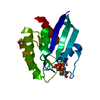 1p2sC 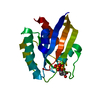 1p2tC 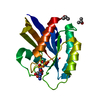 1p2uC 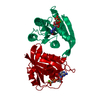 121pS C: citing same article ( S: Starting model for refinement |
|---|---|
| Similar structure data |
- Links
Links
- Assembly
Assembly
| Deposited unit | 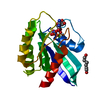
| ||||||||
|---|---|---|---|---|---|---|---|---|---|
| 1 |
| ||||||||
| Unit cell |
|
- Components
Components
| #1: Protein | Mass: 18875.191 Da / Num. of mol.: 1 Source method: isolated from a genetically manipulated source Details: C-TERMINAL TRUNCATION / Source: (gene. exp.)  Homo sapiens (human) / Gene: HRAS OR HRAS1 / Plasmid: pAT / Cell line (production host): JM105 / Production host: Homo sapiens (human) / Gene: HRAS OR HRAS1 / Plasmid: pAT / Cell line (production host): JM105 / Production host:  |
|---|---|
| #2: Chemical | ChemComp-MG / |
| #3: Chemical | ChemComp-HEZ / |
| #4: Chemical | ChemComp-GNP / |
| #5: Water | ChemComp-HOH / |
-Experimental details
-Experiment
| Experiment | Method:  X-RAY DIFFRACTION X-RAY DIFFRACTION |
|---|
- Sample preparation
Sample preparation
| Crystal | Density Matthews: 1.93 Å3/Da / Density % sol: 35.75 % | ||||||||||||||||||||||||||||||||||||||||||
|---|---|---|---|---|---|---|---|---|---|---|---|---|---|---|---|---|---|---|---|---|---|---|---|---|---|---|---|---|---|---|---|---|---|---|---|---|---|---|---|---|---|---|---|
| Crystal grow | *PLUS pH: 7.5 / Method: unknown / Details: Scherer, A., (1989) J.Mol.Biol., 206, 257. | ||||||||||||||||||||||||||||||||||||||||||
| Components of the solutions | *PLUS
|
-Data collection
| Radiation | Protocol: SINGLE WAVELENGTH / Monochromatic (M) / Laue (L): M / Scattering type: x-ray |
|---|---|
| Radiation wavelength | Relative weight: 1 |
| Reflection | Resolution: 2→29.32 Å / Num. all: 10944 / Num. obs: 10944 / Biso Wilson estimate: 15.7 Å2 |
| Reflection | *PLUS Highest resolution: 2.3 Å |
- Processing
Processing
| Software | Name: CNS / Version: 1.1 / Classification: refinement | ||||||||||||||||||||||||||||||||||||||||||||||||||||||||||||||||||||||||||||||||
|---|---|---|---|---|---|---|---|---|---|---|---|---|---|---|---|---|---|---|---|---|---|---|---|---|---|---|---|---|---|---|---|---|---|---|---|---|---|---|---|---|---|---|---|---|---|---|---|---|---|---|---|---|---|---|---|---|---|---|---|---|---|---|---|---|---|---|---|---|---|---|---|---|---|---|---|---|---|---|---|---|---|
| Refinement | Method to determine structure:  MOLECULAR REPLACEMENT MOLECULAR REPLACEMENTStarting model: PDB ENTRY 121P Resolution: 2.3→19.58 Å / Rfactor Rfree error: 0.009 / Data cutoff high absF: 704696.46 / Data cutoff high rms absF: 704696.46 / Data cutoff low absF: 0 / Isotropic thermal model: RESTRAINED / Cross valid method: THROUGHOUT / σ(F): 0 / Stereochemistry target values: Engh & Huber / Details: RESIDUE GLU63 MODELLED AS ALA DUE TO R
| ||||||||||||||||||||||||||||||||||||||||||||||||||||||||||||||||||||||||||||||||
| Solvent computation | Solvent model: FLAT MODEL / Bsol: 35.3608 Å2 / ksol: 0.33039 e/Å3 | ||||||||||||||||||||||||||||||||||||||||||||||||||||||||||||||||||||||||||||||||
| Displacement parameters | Biso mean: 31.8 Å2
| ||||||||||||||||||||||||||||||||||||||||||||||||||||||||||||||||||||||||||||||||
| Refine analyze |
| ||||||||||||||||||||||||||||||||||||||||||||||||||||||||||||||||||||||||||||||||
| Refinement step | Cycle: LAST / Resolution: 2.3→19.58 Å
| ||||||||||||||||||||||||||||||||||||||||||||||||||||||||||||||||||||||||||||||||
| Refine LS restraints |
| ||||||||||||||||||||||||||||||||||||||||||||||||||||||||||||||||||||||||||||||||
| LS refinement shell | Resolution: 2.3→2.44 Å / Rfactor Rfree error: 0.028 / Total num. of bins used: 6
| ||||||||||||||||||||||||||||||||||||||||||||||||||||||||||||||||||||||||||||||||
| Refinement | *PLUS Highest resolution: 2.3 Å / Num. reflection obs: 7088 / Rfactor Rfree: 0.25 / Rfactor Rwork: 0.201 | ||||||||||||||||||||||||||||||||||||||||||||||||||||||||||||||||||||||||||||||||
| Solvent computation | *PLUS | ||||||||||||||||||||||||||||||||||||||||||||||||||||||||||||||||||||||||||||||||
| Displacement parameters | *PLUS | ||||||||||||||||||||||||||||||||||||||||||||||||||||||||||||||||||||||||||||||||
| Refine LS restraints | *PLUS
|
 Movie
Movie Controller
Controller



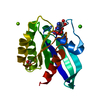

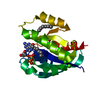
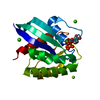
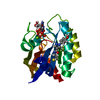
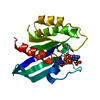
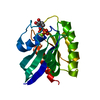
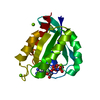


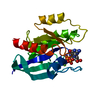

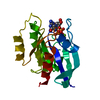

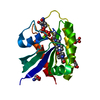
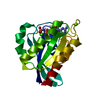
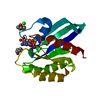

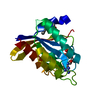
 PDBj
PDBj






















